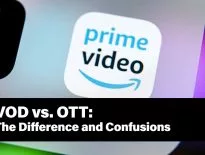Over-the-top advertising platforms are changing the way ad spending works.

It should come as no surprise that the days of cable television are nearly over.
Internet-enabled streaming media solutions have radically disrupted the cable TV industry. People are increasingly turning to their smart TVs, streaming boxes, and game consoles for media content.
As a result, the days of the traditional television commercial may soon be over too. Over-the-top advertising gives brands a new, far more effective way to promote their products and services to media consumers.
What is OTT Advertising?
Over-the-top (OTT) advertising refers to promotional content displayed to people streaming digital media content over the Internet.

Most people rely on OTT devices to consume streamed content. These devices include a wide range of technologies and platforms:
- Streaming Boxes like Apple TV, Amazon Fire TV, and Android TV.
- HDMI Sticks like Chromecast, Roku, or Amazon Fire TV Stick.
- Smart TVs through apps like Netflix and HBO Go.
- Game Consoles like the Playstation 5, Xbox Series X, and Nintendo Switch.
- Computers and Tablets through apps and web browsers.
- Internet-Enabled Blu-Ray Players like the Sony UBP-X700.
All of these devices can stream digital media content online. Unlike regular TVs, there is no need for a special cable subscription. The only subscription you need is to the content provider itself.
There is also no way to show traditional TV commercials to people who use OTT devices. Instead, advertisers need to use specialized OTT platforms to create and deploy ads to streaming media consumers.
Adtech companies are working to improve the way brands and audiences interact through advertising. OTT platforms offer powerful advantages over traditional cable TV advertisements. These enable advertisers to earn more for every dollar they spend displaying branded content to audiences.
But OTT technology isn’t just about helping TV advertisers optimize ad spending. It also gives viewers a far better experience than what cable TV is capable of. Comparing the two will help illustrate how these differences impact ad experiences across streaming platforms.
OTT Advertising vs. TV Commercials

In order to understand the difference between OTT advertising and traditional TV commercials, it’s important to cover how these technologies work.
- TV commercials broadcast the same message to everyone who watches a particular channel. Television networks sell air-time to advertisers, who push their clients’ content onto the station. Brands measure their success in terms of TV ratings.
- OTT advertisements can broadcast unique messages to individual users based on the data they generate using streaming services. Streaming services offer contracts to advertisers, who can choose when and where to place advertisements in a programmatic way. Brands can measure their success according to a wide range of performance indicators.
Some key differences should immediately come into focus. Traditional TV networks and their advertisers are limited by cable infrastructure itself. That infrastructure limits some of the things that they can do. OTT advertisers do not have the same limits.
Let’s look at some of the benefits that OTT advertising offers compared to traditional TV advertisement:

- Audience Segmentation. Television advertisers can only show a single commercial to any channel’s audience at a time. OTT advertisers can segment audiences by almost any data point that audience generates. OTT platforms let advertisers show ads to people based on their demographics, device usage, past purchases, and more.
- User Tracking Capabilities. Television advertisers have no way of tracking viewers or even knowing whether anyone watches their commercials or not. OTT platforms give advertisers information about user engagement, showing how many viewers skipped an ad, how many clicked on it, and much more.
- Content Control. Television viewers can and will skip commercials whenever possible. OTT advertisers can prevent skipping, which means brands can ensure they reach the audiences they have worked so hard to reach. Since the content is personalized, viewers have fewer reasons to avoid ads.
- Immediate Response. Many streaming users watch OTT content on mobile devices. Mobile users can respond immediately to high-quality, personalized ad content that addresses their needs. Compared to traditional TV, the conversion process is practically instant.
- Retargeting Across Channels. With OTT advertising, brands can leverage multiple parts of the online ad environment without being limited to a single device or channel. Brands might address a single audience segment using a combination of streaming advertisements, social media, and more. Integrated advertising strategies like this are not possible.
- Unobtrusive Presentation. For OTT advertisers, interrupting content to display ads is a choice. Many viewers don’t appreciate pausing their content for advertisements. OTT advertisers can choose to display ads as banners or chyrons, improving the experience significantly while still delivering value.
Why Are OTT Commercials on the Rise?

In 2019, Roku released a study showing that half of its users do not have traditional cable or satellite subscriptions. This was before the COVID-19 pandemic turned on-demand content into a powerhouse industry. OTT platforms and streaming providers like Amazon, Netflix, and Roku have soared even more in popularity and value since then.
eMarketer expects OTT ad spending to reach $14 billion by 2023. Several factors contribute to this growth. Together, they paint a picture of a new streaming-oriented media landscape with an emphasis on convenience and individual user agency.
On-demand content empowers viewers to be selective about their content. They can now choose what content they consume, as well as when and where they consume it. The ability to personalize advertising for each individual user fits perfectly in this new media landscape. It serves the needs of individual viewers by paying attention to the things they value most.
OTT ad spend is due to continue increasing as popular streaming services refine the technologies that these ads depend on. Since advertisers can personalize OTT content and track viewer responses to their ads, they have an incentive to make better ads and display them to their most active audiences.
What Types of Ads Can You Buy on OTT Media Services?

Streaming services vary so widely in terms of the technology they use. As a result, they offer many different ways to serve advertisements to users. Each of these OTT advertising models comes with certain advantages and drawbacks, which are unique to the platform that uses them.
The most popular kind of advertising available on today’s OTT media landscape is the ad-supported video-on-demand model (AVOD). Viewers can use these platforms for free without any subscription. AVOD platforms will serve those users ads between (or in the middle of) their content choices.
The biggest AVOD platform streaming service is YouTube. YouTube advertises on every video that passes a certain threshold of views. Controversially, it also claims the ability to use any uploader’s content for its own advertising.
The next most popular ad-supported OTT media service model is the hybrid-supported model. Under this model, users can choose whether to support the streaming service directly through a paid subscription or let the service show them ads in exchange for free (or lower-priced) access.
Hulu and Amazon are good examples of hybrid-supported OTT advertising models. Viewers can opt for a premium subscription to remove ads from their experience. Amazon has a unique spin on this model, where users can pay to digitally rent ad-free content on a case-by-case basis.
Many casual mobile games also use the hybrid-supported model. Users can download a game for free (or pay a small fee to buy it), but must pay more to eliminate ads from the experience.
Most OTT advertising platforms revolve around the following four types of ad experience:
1. Addressable TV Ads
These are ads that networks display to different users consuming the same content. These ads function largely the same way regular TV ads do, except that advertisers can segment them according to their audiences.
This means that advertisers can show ads to users based on any practical data point they have access to. Viewers in a certain geographic area might see ads tailored to their location. Viewers in a certain age group can see ads designed that apply to them, and not see ads targeted for younger or older viewers.
2. Automatic Content Recognition Ads
These ads show based on data about what the viewer is currently watching. By recognizing the content that viewers consume in real-time, these ads can offer immediate value to viewers.
Using automatic content recognition ads, advertisers can target viewers who consume specific content. For streaming platforms with a search function, this enables brands to actively respond to users’ search queries, much like Google Ads does for its search engine.
Advertisers can also use this method to create multiple versions of the same ad. Different variations of a single message may appeal better to certain audiences, enhancing the personalized aspect of ad content.
3. Connected TV Ads
Connected TV ads are a newer form of OTT advertising that inform ad display choices using data gathered from multiple devices on the same network. With connected TV ads, advertisers can choose to display content based on a more complete profile of the individual they are advertising to.
For example, an advertiser may notice that a Playstation 5 user has a Samsung smartphone on the same network. This can enhance the viewer’s ad experience in multiple ways. Advertisers can send the same ad to both devices, or send ads that specifically address owners of either device.
4. Programmatic Ads
Programmatic ads use automated, data-driven systems for targeting users based on the data they generate. These are the ads most people typically associate with the Internet streaming experience. They are highly targeted and offer granular details for maximizing the value of advertising spend.
Programmatic ads offer the greatest level of personalization for viewers. Relatively few OTT platforms offer in-depth programmatic ad tools to their partners, but this number is growing rapidly.
Challenges with OTT Advertisements
OTT advertising allows brands to track user behaviors and measure performance with unprecedented accuracy. One of the main challenges to deploying a successful OTT strategy is selecting the right data to determine ad choices.
This is especially true for advertisers who are used to the TV advertising world, which is dominated by Nielsen ratings and costs-per-impression. In many ways, the OTT environment is similar to paid search marketing – it uses many of the same tools, metrics, and techniques.
The ability to target users based on their behaviors, preferences, and purchases is a significant advantage, but it requires extensive research and attention to detail. Similarly, advertisers have to be careful about how they measure the success of ad campaigns.
How to Buy OTT Ads
In most cases, it’s possible to buy OTT inventory directly from publishers and streaming services. But due to the extra research that has to go into every OTT ad placement, most professionals will partner with an agency that can handle programmatic OTT placement for them.
Some of these agencies offer valuable additional technologies, such as location-based device capture. Many of them maintain readymade consumer databases that help them maximize the effectiveness of ad content. These resources are typically beyond what a single brand can develop on its own, making the case for strategic ad partnership a strong one.
Before you show ads to viewers, you’ll need to show them to your potential partners. Upload your content to a secure video hosting service like Cincopa and use our analytics to drive value.








